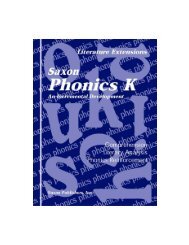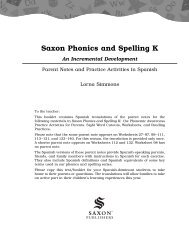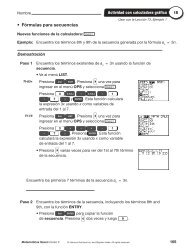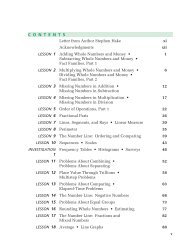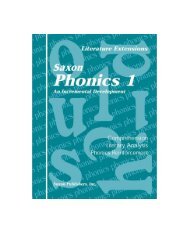Saxon Math Kindergarten GPS Pacing Guide - Saxon Publishers
Saxon Math Kindergarten GPS Pacing Guide - Saxon Publishers
Saxon Math Kindergarten GPS Pacing Guide - Saxon Publishers
You also want an ePaper? Increase the reach of your titles
YUMPU automatically turns print PDFs into web optimized ePapers that Google loves.
<strong>Saxon</strong> <strong>Math</strong><br />
<strong>Kindergarten</strong><br />
<strong>GPS</strong> <strong>Pacing</strong> <strong>Guide</strong>
2<br />
Differentiate Instruction with<br />
the <strong>Saxon</strong> <strong>GPS</strong> <strong>Pacing</strong> <strong>Guide</strong><br />
KINDERGARTEN<br />
Taking Students from Where They Are to Where They Need to Be<br />
<strong>Saxon</strong> <strong>Math</strong> was customized to cover all of<br />
the <strong>GPS</strong> Standards—with a difference!<br />
<strong>Saxon</strong> understands the needs of Georgia teachers<br />
and students. The 2006 Georgia Adoption is a<br />
Transition Adoption for many students—since the<br />
standards are new, students entering school next<br />
year and new to the <strong>GPS</strong> standards will not have<br />
mastered the content from previous grades assumed<br />
by the new <strong>GPS</strong> standards. For ease of use by<br />
teachers, <strong>Saxon</strong> built transition lessons right into the<br />
core program. These lessons cover predecessor<br />
standards on topics such as place value, basic<br />
facts, and operations—foundations that<br />
are crucial to students’ success not only<br />
at grade level, but also for higher level<br />
mathematics.<br />
The <strong>Saxon</strong> <strong>GPS</strong> <strong>Pacing</strong> <strong>Guide</strong> was designed to help<br />
teachers differentiate instruction to ensure that all<br />
Georgia students have the foundations for success<br />
with the new grade-level <strong>GPS</strong> standards.<br />
Introduction
The <strong>Pacing</strong> <strong>Guide</strong> helps teachers differentiate instruction by identifying<br />
which lessons in <strong>Saxon</strong> are transitional [predecessor standards], which<br />
lessons are grade-level lessons [key standards], and which lessons are<br />
extension/enrichment lessons [advanced standards]. To better help you plan<br />
instruction for each Section, scan the <strong>Pacing</strong> <strong>Guide</strong> to identify Predecessor<br />
Standard and Advanced Standard lessons for that Section.<br />
Predecessor Standard Lessons<br />
A quick diagnostic check determines whether predecessor standard lessons<br />
have been mastered or whether they should be retaught. Do all diagnostic<br />
assessments for the Predecessor lessons the fi rst day of each Section.<br />
Advanced Standard Lessons<br />
It is recommended that these lessons are taught if time permits as they<br />
are extensions to key standard lessons. If these lessons are not taught, do<br />
not hold students accountable for problems related to these standards on<br />
subsequent Written Practice pages and assessments.<br />
SAXON MATH K<br />
TEACHER’S MANUAL<br />
Lesson 2<br />
- Exploring teddy bear counters<br />
Lesson 3<br />
- Exploring pattern blocks<br />
Lesson 4<br />
- Exploring pattern blocks<br />
PREDECESSOR<br />
STANDARD<br />
X<br />
X<br />
KEY<br />
STANDARD<br />
MATHEMATICS<br />
See diagnostic check<br />
MKG3.b<br />
ADVANCED<br />
STANDARD<br />
DIAGNOSE /<br />
PRESCRIBE<br />
Provide teddy bear counters.<br />
Ask: “What are these<br />
called?”<br />
Ask: “How can you use<br />
these?”<br />
Provide pattern blocks.<br />
Ask: “What are these<br />
called?”<br />
Ask: “How can you use<br />
these?”<br />
3
4<br />
SAXON MATH K<br />
TEACHER’S MANUAL<br />
Lesson 1<br />
- Exploring teddy bear counters<br />
Lesson 2<br />
- Exploring teddy bear counters<br />
Lesson 3<br />
- Exploring pattern blocks<br />
Lesson 4<br />
- Exploring pattern blocks<br />
Lesson 5<br />
- Placing a picture on a<br />
pictograph<br />
Lesson 6<br />
- Reading a graph<br />
- Exploring teddy bear counters<br />
and pattern blocks<br />
Lesson 7<br />
- Counting to 5 with one-to-one<br />
correspondence<br />
Lesson 8<br />
- Exploring linking cubes<br />
- Counting to 5 with one-to-one<br />
correspondence<br />
Lesson 9<br />
- Creating an AB color pattern<br />
- Counting to 5 with one-to-one<br />
correspondence<br />
*Extension to Key Standards<br />
PREDECESSOR<br />
STANDARD<br />
X<br />
X<br />
X<br />
KEY<br />
STANDARD<br />
MATHEMATICS<br />
MKG3.b<br />
MKD1<br />
MKN2.a<br />
MKN1.a<br />
MKN1.a, MKN1.e<br />
MKN1.a, MKN1.e<br />
KINDERGARTEN<br />
ADVANCED<br />
STANDARD<br />
DIAGNOSE /<br />
PRESCRIBE<br />
Provide teddy bear counters.<br />
Ask: “What are these<br />
called?”<br />
Ask: “How can you use<br />
these?”<br />
Provide teddy bear counters.<br />
Ask: “What are these<br />
called?”<br />
Ask: “How can you use<br />
these?”<br />
Provide pattern blocks.<br />
Ask: “What are these<br />
called?”<br />
Ask: “How can you use<br />
these?”
SAXON MATH K<br />
TEACHER’S MANUAL<br />
Lesson 10<br />
- Oral assessment 1: identifying<br />
and naming shapes<br />
Lesson 11<br />
- Placing an object on a real<br />
graph<br />
- Identifying most and fewest on<br />
a graph<br />
Lesson 12<br />
- Using positional words and<br />
phrases: over, under, on top of,<br />
behind, in back of, in front of,<br />
beside, inside, and outside<br />
Lesson 13<br />
- Counting to 10 with one-toone<br />
correspondence<br />
Lesson 14<br />
- Creating pattern-block designs<br />
Lesson 15<br />
- Covering designs using pattern<br />
blocks<br />
Lesson 16<br />
- Sorting by color<br />
Lesson 17<br />
- Sorting by color<br />
- Creating a real graph<br />
Lesson 18<br />
- Acting out story problems<br />
Lesson 19<br />
- Identifying circles and<br />
rectangles<br />
PREDECESSOR<br />
STANDARD<br />
X<br />
KEY<br />
STANDARD<br />
MATHEMATICS<br />
MKG1.a<br />
MKN1.a, KKD1<br />
MKG2.a, MKG2.b<br />
MKN1.a<br />
MKG1.d*<br />
MKG1.d<br />
MKM1.a, MKD1<br />
MKN2.c, MKP1.a<br />
MKG1.a, MKG1.c<br />
ADVANCED<br />
STANDARD<br />
DIAGNOSE /<br />
PRESCRIBE<br />
Ask: “Sort these pattern<br />
blocks by color.”<br />
*Extension to Key Standards<br />
5
6<br />
SAXON MATH K<br />
TEACHER’S MANUAL<br />
Lesson 20<br />
- Oral assessment 2: counting<br />
by 1’s to 100<br />
Lesson 21<br />
- Identifying and ordering the<br />
numbers 1-5<br />
- Identifying a missing number<br />
Lesson 22<br />
- Placing an object on a real<br />
graph<br />
- Identifying most and fewest on<br />
a graph<br />
Lesson 23<br />
- Naming a shape piece using<br />
three attributes (shape, color,<br />
and size)<br />
Lesson 24<br />
- Naming a shape piece using<br />
three attributes (shape, color,<br />
and size)<br />
- Describing the relative position<br />
of objects<br />
Lesson 25<br />
- Creating and reading an AB<br />
color pattern<br />
Lesson 26<br />
- Creating and reading an AB<br />
color pattern<br />
Lesson 27<br />
- Acting out story problems<br />
Lesson 28<br />
- Identifying ordinal position to<br />
fourth<br />
*Extension to Key Standards<br />
PREDECESSOR<br />
STANDARD<br />
KEY<br />
STANDARD<br />
MATHEMATICS<br />
MKN1.a*<br />
MKP5*<br />
MKN1.e, MKM1.a,<br />
MKD1<br />
MKG1.a<br />
MKG3.a, MKG3.b<br />
MKG3.a, MKG3.b<br />
MKN1.a, MKN2.a,<br />
MKN2.c<br />
MKN1.d<br />
KINDERGARTEN<br />
ADVANCED<br />
STANDARD<br />
M1N1.b<br />
DIAGNOSE /<br />
PRESCRIBE
SAXON MATH K<br />
TEACHER’S MANUAL<br />
Lesson 29<br />
- Covering designs using pattern<br />
blocks<br />
Lesson 30<br />
- Oral assessment 3: identifying<br />
the numbers 0-10 sequencing<br />
the numbers 0-10<br />
Lesson 31<br />
- Identifying triangles and<br />
squares<br />
Lesson 32<br />
- Naming a shape piece using<br />
three attributes (shape, color,<br />
and size)<br />
- Describing the relative position<br />
of objects<br />
Lesson 33<br />
- Identifying and creating AB<br />
sound and movement patterns<br />
Lesson 34<br />
- Sorting a collection of objects<br />
Lesson 35<br />
- Ordering the numbers 1-10<br />
- Identifying a missing number<br />
Lesson 36<br />
- Ordering the numbers 0-10<br />
- Counting backward from 10<br />
Lesson 37<br />
- Identifying ordinal position to<br />
fourth<br />
Lesson 38<br />
- Ordering the numbers 0-10<br />
- Identifying a missing number<br />
PREDECESSOR<br />
STANDARD<br />
X<br />
KEY<br />
STANDARD<br />
MATHEMATICS<br />
MKG1.d<br />
MKP5*<br />
MKG1.a, MKG1.c<br />
MKG3.b*<br />
MKP5*<br />
MKN1.a*, MKP5*<br />
MKN1.d<br />
ADVANCED<br />
STANDARD<br />
M1G3<br />
M1N1.d<br />
DIAGNOSE /<br />
PRESCRIBE<br />
Use a collection of objects.<br />
Ask: “Sort these objects.”<br />
*Extension to Key Standards<br />
7
8<br />
SAXON MATH K<br />
TEACHER’S MANUAL<br />
*Extension to Key Standards<br />
PREDECESSOR<br />
STANDARD<br />
Lesson 39<br />
- Identifying the numbers 0-9 X<br />
Lesson 40<br />
- Sequencing daily events<br />
- Oral assessment 4: counting<br />
objects in a set; matching sets<br />
of objects using one-to-one<br />
correspondences<br />
Problem-Solving Activity 4:<br />
Solving a Problem by Looking<br />
for a Pattern<br />
KEY<br />
STANDARD<br />
MATHEMATICS<br />
MKN1.a, MKN1.e,<br />
MKM3.a, MKP5<br />
MKP1.a, MKP1.b,<br />
MKP2, MKP3,<br />
MKP5<br />
Performance Task 4 MKG3.a, MKP1.a,<br />
MKP1.b,<br />
MKP3, MKP5<br />
Lesson 41<br />
- Identifying pennies<br />
- Counting pennies<br />
Lesson 42<br />
- Matching a number card (0-<br />
10) to set of objects<br />
Lesson 43<br />
- Naming a shape piece using<br />
three attributes (shape, color,<br />
and size)<br />
- Identifying a missing piece in a<br />
matrix<br />
- Describing the relative position<br />
of objects<br />
Lesson 44<br />
- Acting out story problems<br />
using pennies<br />
Lesson 45<br />
- Identifying time to the hour<br />
MKN1.h<br />
MKN1.a<br />
MKN2.a, MKP1.a<br />
MKM3.b<br />
KINDERGARTEN<br />
ADVANCED<br />
STANDARD<br />
M1G3<br />
DIAGNOSE /<br />
PRESCRIBE<br />
Use number cards 0-9.<br />
Ask: “What is this<br />
number?”
SAXON MATH K<br />
TEACHER’S MANUAL<br />
Lesson 46<br />
- Identifying ordinal position to<br />
fourth<br />
Lesson 47<br />
- Showing time to the hour on a<br />
clock<br />
Lesson 48<br />
- Identifying the numbers 0-10<br />
- Identifying before, after, and<br />
between<br />
Lesson 49<br />
- Writing money amounts to 10¢<br />
- Ordering money amounts to<br />
10¢<br />
Lesson 50<br />
- Identifying the day of the week<br />
when weekly events occur in<br />
class<br />
- Oral assessment 5: matching<br />
sets and numbers<br />
Problem-Solving Activity 5:<br />
Solving a Problem by Acting<br />
It Out; Solving a Problem by<br />
Drawing a Picture<br />
PREDECESSOR<br />
STANDARD<br />
KEY<br />
STANDARD<br />
MATHEMATICS<br />
MKM1.d<br />
MKM3.b<br />
MKP5*<br />
MKN1.i<br />
MKM3.c, MKP1.a<br />
MKP1.b, MKP2,<br />
MKP3, MKP5<br />
Performance Task 5 MKN2.c , MKP3,<br />
MKP5<br />
Lesson 51<br />
- Paying for items to 10¢ using<br />
pennies<br />
Lesson 52<br />
- Copying patterns<br />
- Identifying an AB pattern<br />
MKN1.i<br />
MKG3.b<br />
ADVANCED<br />
STANDARD<br />
DIAGNOSE /<br />
PRESCRIBE<br />
*Extension to Key Standards<br />
9
10<br />
SAXON MATH K<br />
TEACHER’S MANUAL<br />
Lesson 53<br />
- Comparing objects by weight<br />
(mass)<br />
Lesson 54<br />
- Naming a shape piece using<br />
two attributes (shape and<br />
color)<br />
- Identifying a missing piece in a<br />
matrix<br />
- Describing the relative position<br />
of objects<br />
Lesson 55<br />
- Copying patterns<br />
- Identifying AB and ABB<br />
patterns<br />
Lesson 56<br />
- Exploring a geoboard<br />
Lesson 57<br />
- Making shapes on a geoboard<br />
Lesson 58<br />
- Placing an object on a real<br />
graph<br />
Lesson 59<br />
- Identifying ordinal position<br />
- Paying for items using pennies<br />
Lesson 60<br />
- Creating, describing, and<br />
extending shape patterns<br />
- Oral assessment 6 : sorting<br />
and identifying the sorting rule<br />
Problem-Solving Activity 6:<br />
Solving a Problem by Acting<br />
It Out<br />
*Extension to Key Standards<br />
PREDECESSOR<br />
STANDARD<br />
KEY<br />
STANDARD<br />
MATHEMATICS<br />
MKM1.d<br />
MKG2.a, MKG3.a<br />
MKG3.b<br />
MKG1.d*<br />
MKG1.a<br />
MKD1<br />
MKN1.d, MKN1.i<br />
MKG3.b, MKP3,<br />
MKP5<br />
MKP1.a, MKP1.b,<br />
MKP2, MKP3,<br />
MKP5<br />
KINDERGARTEN<br />
ADVANCED<br />
STANDARD<br />
DIAGNOSE /<br />
PRESCRIBE
SAXON MATH K<br />
TEACHER’S MANUAL<br />
PREDECESSOR<br />
STANDARD<br />
KEY<br />
STANDARD<br />
MATHEMATICS<br />
Performance Task 6 MKN1.g,<br />
MKP1.a, MKP1.b,<br />
MKP3, MKP5<br />
Lesson 61<br />
- Identifying a cube<br />
- Comparing a cube and a<br />
square<br />
- Counting with one-to-one<br />
correspondence<br />
Lesson 62<br />
- Matching a number card (0-<br />
10) to a set of objects<br />
Lesson 63<br />
- Copying line segments, shapes,<br />
and designs on a geoboard<br />
Lesson 64<br />
- Estimating collections<br />
- Counting by 10’s<br />
Lesson 65<br />
- Identifying dimes<br />
- Trading 10 pennies for a dime<br />
- Comparing events according to<br />
duration of time<br />
- Counting by 10’s<br />
Lesson 66<br />
- Identifying and creating ABB<br />
sound and movement patterns<br />
Lesson 67<br />
- Counting dimes to 50¢<br />
Lesson 68<br />
- Paying for items to 50¢ using<br />
dimes<br />
MKN1.a, MKG1.b,<br />
MKG1.e<br />
MKN1.c*<br />
MKG1.a, MKG1.d<br />
MKN1.f<br />
MKN1.h, MKN1.j<br />
MKG3.b<br />
MKN1.h<br />
MKN1.h<br />
ADVANCED<br />
STANDARD<br />
DIAGNOSE /<br />
PRESCRIBE<br />
*Extension to Key Standards<br />
11
12<br />
SAXON MATH K<br />
TEACHER’S MANUAL<br />
Lesson 69<br />
- Matching a number card (0-<br />
10) to set of objects<br />
Lesson 70<br />
- Making models for number<br />
words through ten<br />
- Oral assessment 7: copying<br />
and extending patterns<br />
Problem-Solving Activity 7:<br />
Solving a Problem by<br />
Guessing and Checking<br />
*Extension to Key Standards<br />
PREDECESSOR<br />
STANDARD<br />
KEY<br />
STANDARD<br />
MATHEMATICS<br />
MKN1.c*<br />
MKN1.b, MKG3.b<br />
MKP1.a, MKP1.b,<br />
MKP2, MKP3,<br />
MKP5<br />
Performance Task 7 MKG1.d,<br />
MKP1.a, MKP1.b,<br />
MKP3, MKP5<br />
Lesson 71<br />
- Comparing sets of objects<br />
- Comparing numbers<br />
through 6<br />
Lesson 72<br />
- Weighing objects using<br />
nonstandard units<br />
- Ordering objects by weight<br />
Lesson 73<br />
- Combing sets by counting on<br />
Lesson 74<br />
- Identifying the numbers 0-20<br />
- Ordering the numbers 0-20<br />
Lesson 75<br />
- Identifying the numbers 0-20<br />
- Identifying before, after, and<br />
between<br />
Lesson 76<br />
- Identifying the numbers<br />
10-20<br />
MKN1.e<br />
MKM1.d<br />
MKN1.e<br />
MKP5*<br />
MKP5*<br />
KINDERGARTEN<br />
ADVANCED<br />
STANDARD<br />
M1N1.d<br />
DIAGNOSE /<br />
PRESCRIBE
SAXON MATH K<br />
TEACHER’S MANUAL<br />
Lesson 77<br />
- Identifying a 1-cup measuring<br />
cup<br />
- Following a recipe<br />
Lesson 78<br />
- Identifying full, half-full, and<br />
empty containers<br />
- Identifying a quart container<br />
Lesson 79<br />
- Covering a design in more<br />
than one way<br />
Lesson 80<br />
- Matching a number card (11-<br />
20) to a set of objects<br />
- Oral assessment 8: identifying<br />
ordinal position<br />
Problem-Solving Activity 8:<br />
Solving a Problem by Acting<br />
It Out; Solving a Problem by<br />
Drawing a Picture<br />
PREDECESSOR<br />
STANDARD<br />
KEY<br />
STANDARD<br />
MATHEMATICS<br />
MKM1.b*<br />
MKM1.b<br />
MKG1.d<br />
MKN1.d<br />
MKP1.a, MKP1.b,<br />
MKP2, MKP3,<br />
MKP5<br />
Performance Task 8 MKN2.c, MKP1.a,<br />
MKP1.b, MKP3,<br />
MKP5<br />
Lesson 81<br />
- Paying for items to $1.00 using<br />
dimes<br />
Lesson 82<br />
- Identifying the seasons of the<br />
year<br />
- Comparing temperatures at<br />
different times of the year<br />
- Placing a tag on a pictograph<br />
MKM2.c, MKD1<br />
ADVANCED<br />
STANDARD<br />
M1N1.e<br />
DIAGNOSE /<br />
PRESCRIBE<br />
*Extension to Key Standards<br />
13
14<br />
SAXON MATH K<br />
TEACHER’S MANUAL<br />
Lesson 83<br />
- Comparing length<br />
- Identifying shorter and longer<br />
Lesson 84<br />
- Ordering four objects by length<br />
Lesson 85<br />
- Naming a shape piece using<br />
three attributes (shape, color,<br />
and size)<br />
Lesson 86<br />
- Copying line segments, shapes,<br />
and designs on a geoboard<br />
Lesson 87<br />
- Ordering objects by length<br />
- Measuring length using<br />
nonstandard units<br />
Lesson 88<br />
- Making an ABC pattern using<br />
pattern blocks<br />
Lesson 89<br />
- Acting out “some, some more”<br />
and “some, some went away”<br />
stories<br />
Lesson 90<br />
- Estimating and measuring the<br />
capacity of containers using<br />
nonstandard units<br />
- Comparing and ordering<br />
containers by capacity<br />
- Writing numerals through 20<br />
to label sets<br />
- Oral assessment 9: creating a<br />
real graph<br />
*Extension to Key Standards<br />
PREDECESSOR<br />
STANDARD<br />
KEY<br />
STANDARD<br />
MATHEMATICS<br />
MKM1.a<br />
MKM1.a<br />
MKG3.a<br />
MKG1.c, MKG1.d<br />
MKM1.a<br />
MKG3.b<br />
MKP1.a<br />
MKN1.b, MKN1.c,<br />
MKD1<br />
KINDERGARTEN<br />
ADVANCED<br />
STANDARD<br />
DIAGNOSE /<br />
PRESCRIBE
SAXON MATH K<br />
TEACHER’S MANUAL<br />
Problem-Solving Activity 9:<br />
Solving a Problem by Guessing<br />
and Checking<br />
PREDECESSOR<br />
STANDARD<br />
KEY<br />
STANDARD<br />
MATHEMATICS<br />
MKP1.a, MKP1.b,<br />
MKP2, MKP3,<br />
MKP5<br />
Performance Task 9 MKN1.i, MKP1.a,<br />
MKP1.b,<br />
MKP3, MKP5<br />
Lesson 91<br />
- Identifying nickels<br />
- Trading 5 pennies for a nickel<br />
- Comparing events according to<br />
duration of time counting<br />
by 5’s<br />
Lesson 92<br />
- Counting nickels to 25¢<br />
Lesson 93<br />
- Identifying a cylinder<br />
- Comparing cylinder and a circle<br />
- Ordering objects by height<br />
Lesson 94<br />
- Paying for items to 25¢ using<br />
nickels<br />
Lesson 95<br />
- Identifying and creating ABC<br />
sound and movement patterns<br />
Lesson 96<br />
- Paying for items to 50¢ using<br />
nickels<br />
Lesson 97<br />
- Dividing by sharing<br />
Lesson 98<br />
- Identifying and ordering<br />
numbers<br />
MKN1.i, MKN1.j<br />
MKM1.c, MKG1.e<br />
MKG3.b<br />
MKN1.g<br />
MKP5*<br />
ADVANCED<br />
STANDARD<br />
M1N1.e<br />
M1N1.e<br />
M1N1.e<br />
DIAGNOSE /<br />
PRESCRIBE<br />
*Extension to Key Standards<br />
15
16<br />
SAXON MATH K<br />
TEACHER’S MANUAL<br />
Lesson 99<br />
- Comparing numbers<br />
through 10<br />
Lesson 100<br />
- Estimating quantities using fi ve<br />
or ten as a benchmark<br />
- Oral assessment 10: naming<br />
the days of the week; copying<br />
geoboard designs<br />
Problem-Solving Activity 10:<br />
Solving a Problem by Drawing<br />
a Picture<br />
*Extension to Key Standards<br />
PREDECESSOR<br />
STANDARD<br />
KEY<br />
STANDARD<br />
MATHEMATICS<br />
MKN1.e<br />
MKN1.f, MKG1.d,<br />
MKM2.a<br />
MKP1.a, MKP1.b,<br />
MKP2, MKP3,<br />
MKP5<br />
Performance Task 10 MKN2.c, MKP1.a,<br />
MKP1.b, MKP3,<br />
MKP5,<br />
Lesson 101<br />
- Making an ABBC pattern using<br />
pattern blocks<br />
Lesson 102<br />
- Dividing by sharing<br />
- Comparing numbers<br />
through 10<br />
Lesson 103<br />
- Identifying right and left<br />
Lesson 104<br />
- Exploring tangrams<br />
Lesson 105<br />
- Sorting and identifying<br />
tangram pieces<br />
- Identifying small, medium, and<br />
large shapes<br />
- Covering designs using<br />
tangrams<br />
MKG3.b<br />
MKN1.a, MKN1.e,<br />
MKN1.g<br />
MKP5<br />
MKG1.a, MKG1.d<br />
KINDERGARTEN<br />
ADVANCED<br />
STANDARD<br />
M1G3<br />
DIAGNOSE /<br />
PRESCRIBE
SAXON MATH K<br />
TEACHER’S MANUAL<br />
Lesson 106<br />
- Measuring length using<br />
nonstandard units<br />
- Estimating and measuring<br />
length and using nonstandard<br />
units<br />
Lesson 107<br />
- Graphing a picture on a<br />
pictograph<br />
Lesson 108<br />
- Covering designs using<br />
tangrams<br />
- Exploring slides, turns, and fl ips<br />
Lesson 109<br />
- Identifying the relationship<br />
between larger and smaller<br />
numbers<br />
- Counting forward and<br />
backward on a number line<br />
Lesson 110<br />
- Identifying ordinal position to<br />
tenth<br />
- Oral assessment 11:<br />
identifying a penny, a nickel,<br />
and a dime<br />
- Acting out addition and<br />
subtraction stories<br />
Problem-Solving Activity 11:<br />
Solving a Problem by Drawing<br />
a Picture and Looking for a<br />
Pattern<br />
PREDECESSOR<br />
STANDARD<br />
KEY<br />
STANDARD<br />
MATHEMATICS<br />
MKM1.a<br />
MKD1<br />
MKG1.d<br />
MKN1.d, MKN1.h,<br />
MKP1.b<br />
MKP1.a, MKP1.b,<br />
MKP2, MKP3,<br />
MKP5<br />
Performance Task 11 MKP3.b, MKP1.a,<br />
MKP1.b, MKP3,<br />
MKP5<br />
ADVANCED<br />
STANDARD<br />
M1N1.d<br />
DIAGNOSE /<br />
PRESCRIBE<br />
*Extension to Key Standards<br />
17
18<br />
SAXON MATH K<br />
TEACHER’S MANUAL<br />
Lesson 111<br />
- Identifying the numbers<br />
11-30<br />
Lesson 112<br />
- Identifying a sphere<br />
- Comparing a sphere and circle<br />
- Ordering objects by size<br />
Lesson 113<br />
- Sorting coins<br />
- Identifying which of two<br />
activities takes more or less<br />
time<br />
- Identifying a quarter and a<br />
dollar<br />
Lesson 114<br />
- Covering designs using<br />
tangrams<br />
- Exploring slides, turns and fl ips<br />
Lesson 115<br />
- Identifying largest and smallest<br />
shapes<br />
- Identifying and covering half of<br />
a shape<br />
Lesson 116<br />
- Paying for items using pennies,<br />
nickels, dimes, or a quarter<br />
Lesson 117<br />
- Identifying and matching<br />
equivalent sets<br />
- Identifying doubles<br />
Lesson 118<br />
- Identifying and matching<br />
equivalent sets<br />
- Identifying doubles<br />
*Extension to Key Standards<br />
PREDECESSOR<br />
STANDARD<br />
X<br />
KEY<br />
STANDARD<br />
MATHEMATICS<br />
MKP5*<br />
MKG1.b, MKG1.e<br />
MKN1.h<br />
MKG1.d<br />
MKN1.i<br />
MKN1.e, MKN2.b<br />
MKN1.e, MKN2.b<br />
KINDERGARTEN<br />
ADVANCED<br />
STANDARD<br />
DIAGNOSE /<br />
PRESCRIBE<br />
Use shapes of varying sizes.<br />
Ask: “Point to the smallest<br />
_____ or the largest<br />
______?”
SAXON MATH K<br />
TEACHER’S MANUAL<br />
Lesson 119<br />
- Acting out “some, some more”<br />
stories<br />
Lesson 120<br />
- Estimating and measuring the<br />
capacity of containers using<br />
nonstandard units<br />
- Ordering containers by capacity<br />
- Writing numerals through 30<br />
to label sets<br />
- Oral assessment 12: counting<br />
by 10’s to 100 comparing and<br />
measuring length<br />
Problem-Solving Activity 12:<br />
Solving a Problem by Guessing<br />
and Checking<br />
PREDECESSOR<br />
STANDARD<br />
KEY<br />
STANDARD<br />
MATHEMATICS<br />
MKP1.b<br />
MKN1.a, MKN1.b<br />
MKP1.a, MKP1.b,<br />
MKP2, MKP3,<br />
MKP5<br />
Performance Task 12 MKN2.a, MKP1.a,<br />
MKP1.b, MKP1.3,<br />
MKP1.5<br />
Lesson 121<br />
- Drawing pictures for “some,<br />
some more” stories<br />
Lesson 122<br />
- Recording the answer to a<br />
question on a chart<br />
- Determining questions for a<br />
two-choice survey<br />
Lesson 123<br />
- Identifying a cone<br />
- Sorting three-dimensional<br />
objects<br />
MKN2.c<br />
MKD1<br />
ADVANCED<br />
STANDARD<br />
M1G1.b<br />
DIAGNOSE /<br />
PRESCRIBE<br />
*Extension to Key Standards<br />
19
20<br />
SAXON MATH K<br />
TEACHER’S MANUAL<br />
Lesson 124<br />
- Identifying the time of day as<br />
day or night<br />
- Identifying the time of day as<br />
morning, afternoon, or evening<br />
- Sequencing events that happen<br />
during the day<br />
- Comparing temperatures at<br />
different times of the day<br />
- Identifying the likelihood of<br />
events<br />
- Identifying events as more<br />
likely, equally likely, or less<br />
likely<br />
Lesson 125<br />
- Counting by 2’s<br />
- Identifying even and odd<br />
numbers to 10<br />
Lesson 126<br />
- Measuring distance using<br />
nonstandard units<br />
Lesson 127<br />
- Acting out “some, some went<br />
away” stories<br />
Lesson 128<br />
- Drawing pictures for “some,<br />
some went away” stories<br />
Lesson 129<br />
- Identifying and making<br />
symmetrical designs<br />
*Extension to Key Standards<br />
PREDECESSOR<br />
STANDARD<br />
KEY<br />
STANDARD<br />
MATHEMATICS<br />
MKM3.a<br />
MKM1.a<br />
MKP1.a<br />
MKN2.c<br />
MKP5*<br />
KINDERGARTEN<br />
ADVANCED<br />
STANDARD<br />
M1N3.b<br />
DIAGNOSE /<br />
PRESCRIBE
SAXON MATH K<br />
TEACHER’S MANUAL<br />
Lesson 130<br />
- Counting pennies to pay for<br />
items that together cost less<br />
than 30 cents<br />
- Writing numeral through 30 to<br />
label sets<br />
- Oral assessment 13: counting<br />
by 5’s to 50; identifying<br />
geometric solids; covering<br />
designs using tangrams<br />
Problem-Solving Activity 13:<br />
Solving a Problem by Acting<br />
It Out; Solving a Problem by<br />
Drawing a Picture<br />
PREDECESSOR<br />
STANDARD<br />
KEY<br />
STANDARD<br />
MATHEMATICS<br />
MKN1.c, MKN1.i,<br />
MKG1.b<br />
MKP1.a, MKP1.b,<br />
MKP2, MKP3,<br />
MKP5<br />
Performance Task 13 MKN2.c,<br />
MKP1.a, MKP1.b,<br />
MKP3, MKP5<br />
Lesson 131<br />
- Using indirect comparisons to<br />
compare the heights or lengths<br />
of objects<br />
Lesson 132<br />
Identifying hot and cold objects<br />
Lesson 133<br />
- Measuring length using inches<br />
Lesson 134<br />
- Identifying halves and fourths<br />
Lesson 135<br />
- Placing a tag on a pictograph<br />
X<br />
MKM1.a, MKM1.c<br />
MKM1.a*<br />
MKD1<br />
ADVANCED<br />
STANDARD<br />
M1N4.c<br />
TOTAL DAYS 8 123 14<br />
DIAGNOSE /<br />
PRESCRIBE<br />
Use pictures of different hot<br />
and cold objects.<br />
Ask: “Which of these<br />
objects are cold?”<br />
Ask: “Point to an object<br />
that is hot.”<br />
*Extension to Key Standards<br />
21
www.<strong>Saxon</strong><strong>Publishers</strong>.com<br />
800.284.7019<br />
©2006 Harcourt Achieve. All rights reserved.<br />
9994038524<br />
FSS#141GAPcngGdKinder/JW/4.11.2006



